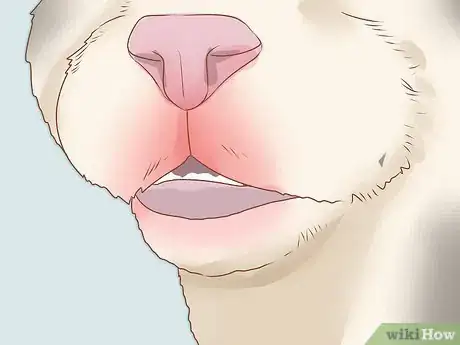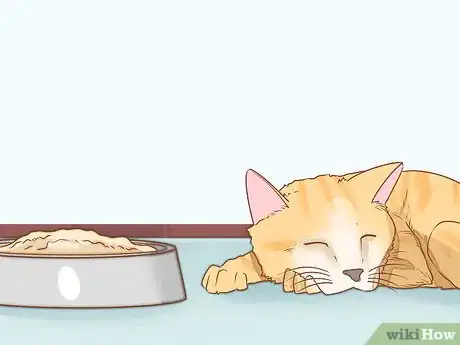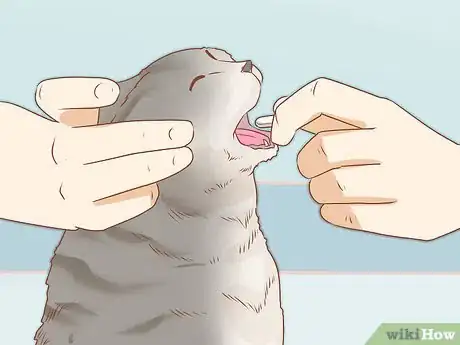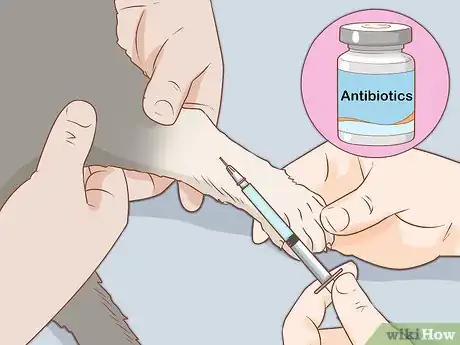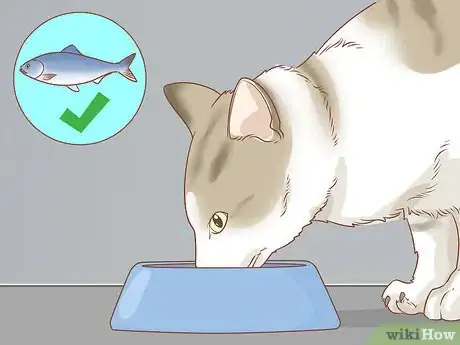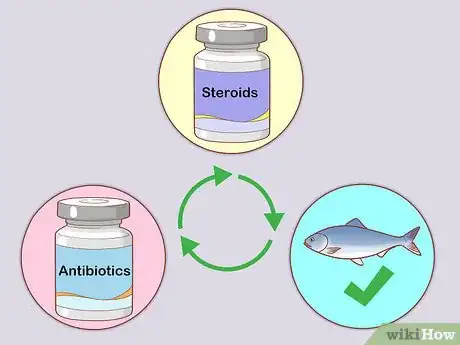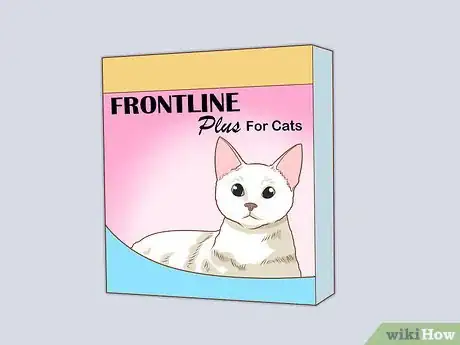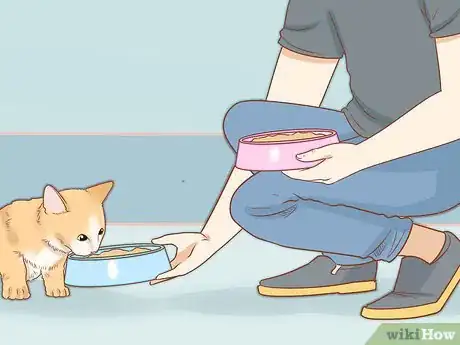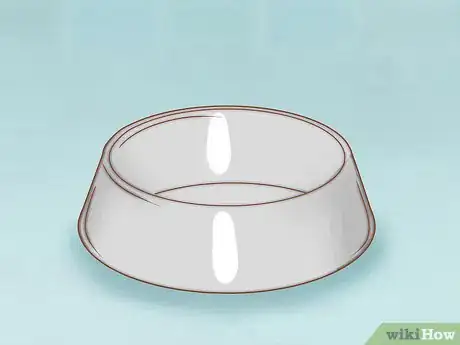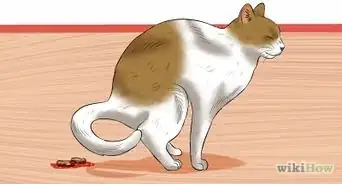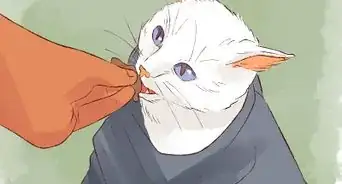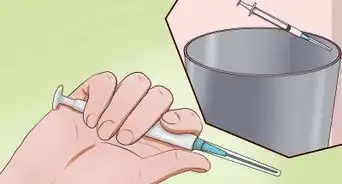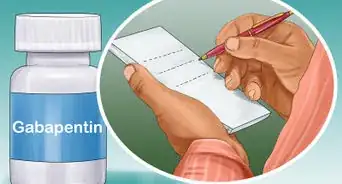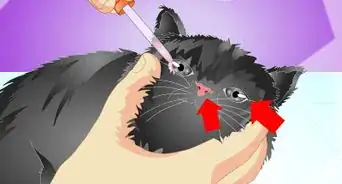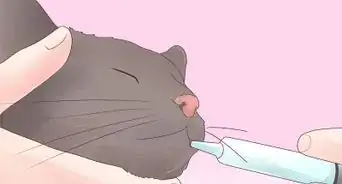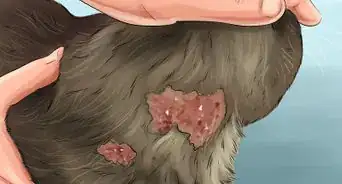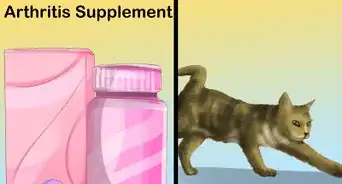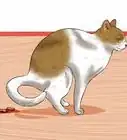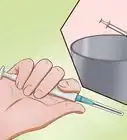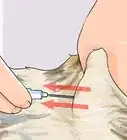This article was co-authored by Pippa Elliott, MRCVS. Dr. Elliott, BVMS, MRCVS is a veterinarian with over 30 years of experience in veterinary surgery and companion animal practice. She graduated from the University of Glasgow in 1987 with a degree in veterinary medicine and surgery. She has worked at the same animal clinic in her hometown for over 20 years.
This article has been viewed 78,291 times.
Rodent ulcers, or Eosinophilic Granulomas, were originally believed to be caused by rodent bites on the cat’s mouth and lips. It is now known that these ulcers are not related to rodents in any way, and are actually a result of an allergic reaction. In order to diagnose and treat rodent ulcers in cats, you should identify the ulcers, seek veterinary assistance, and then treat the underlying allergy.[1]
Steps
Identifying Rodent Ulcers in Cats
-
1Look for sores on the lips and mouth. Rodent ulcers are characterized by the development of sores or lesions on the lips and mouth of the cat and can sometimes be quite large. The upper lip area is the most common place for sores to develop. Inspect your cat’s mouth if you see sores appearing on the upper lip, there will be a loss of tissue with the area appearing red or orange-yellow.
- The sores may be covered in scabs, or they may bleed and give off a foul odor.
- An ulcer may recur if the cat has had them before.
- In rare instances, sores may develop on other areas of the body.
-
2Notice if your cat has a decreased appetite. In some cases when a cat is inflicted with rodent ulcers it will stop eating or it will eat less than normal. This is because the lesions on their mouth are sore making it painful to chew food.
- If you notice your cat has a decreased appetite you should check for sores and take it to the vet.
Advertisement -
3Determine if your cat is in pain. The cat may exhibit signs of pain caused by the rodent ulcers. For example, the cat may hide or become aggressive. If your cat demonstrates any major behavioral changes, including a lack of grooming, you should check for sores and take it to the vet.
-
4Ask your vet to examine the ulcers. If your cat has developed sores on its lips and inside its mouth, you should consult your vet for a formal diagnosis. Your vet will be able to diagnose rodent ulcers simply by examining the lesions.[2]
- In rare instances the veterinarian may need to perform a biopsy to ensure that the ulcers are not cancerous. This typically only happens if the ulcers do not respond to treatment.
Removing Rodent Ulcers
-
1Treat the ulcers with steroid injections. Steroid injections are the most common way to treat rodent ulcers in cats. Your veterinarian will give the cat an injection in order to treat the ulcer. Depending on the chosen steroid, these injections will be given once every two to three weeks, until the sores have disappeared.[3]
-
2Give your cat steroid pills. Rodent ulcers can also be treated by giving your cat prednisone orally. Your veterinarian will prescribe pills that are given orally every 24 hours until the lesions are gone. In order to properly administer the medication, follow the directions provided by your veterinarian.[4]
-
3Administer antibiotics. In some instances the ulcers may become infected. If this happens, your vet will likely prescribe an antibiotic in order to treat the infection alongside the lesions. Take the antibiotics as directed by the veterinarian.[5]
-
4Try a food that contains essential fatty acids. Some vets believe that essential fatty acids can help relieve stress in cats and reduce allergic reactions in some instances. If you are not feeding your cat a premium food, they may not get enough fatty acid in their diet. Change to a new food that is higher in essential fatty acids or give your cat a supplement, as directed by their vet.[6]
-
5Repeat treatments as necessary. Rodent ulcers are typically caused by an allergic reaction. As a result, they may recur if you are unable to determine what is causing the allergy. If the ulcers return, take your cat to the vet and repeat the treatment.
Treating Underlying Allergies
-
1Give your cat flea prevention medicine. Some cats will have an allergic skin reaction to fleas. This reaction can cause rodent ulcers to develop. If your vet suspects that fleas may have caused the development of the ulcers, you will need to treat the fleas and prevent future infestations. Talk with your vet about the best treatment and prevention option for your cat.[7]
- For example, your vet may prescribe Advantage or Frontline Plus which are given monthly and treat and prevent fleas.
-
2Change the cat’s food. Some cats have food allergies that could contribute to the formation of rodent ulcers. Your vet can help conduct a food allergy trial to determine if food is causing the ulcers. Once you have discovered the cause, change your cat’s food to prevent future outbreaks.[8]
-
3Use stainless steel food bowls. The rodent ulcers may be caused by an allergic reaction to plastic or rubber. For example, if your cat eats and drinks from plastic or rubber bowls, you should consider switching to stainless steel bowls. Stainless steel is less likely to cause an allergic reaction.[9]
Expert Q&A
-
QuestionAre rodent ulcers in cats contagious?
 Pippa Elliott, MRCVSDr. Elliott, BVMS, MRCVS is a veterinarian with over 30 years of experience in veterinary surgery and companion animal practice. She graduated from the University of Glasgow in 1987 with a degree in veterinary medicine and surgery. She has worked at the same animal clinic in her hometown for over 20 years.
Pippa Elliott, MRCVSDr. Elliott, BVMS, MRCVS is a veterinarian with over 30 years of experience in veterinary surgery and companion animal practice. She graduated from the University of Glasgow in 1987 with a degree in veterinary medicine and surgery. She has worked at the same animal clinic in her hometown for over 20 years.
Veterinarian No, rodent ulcers are not contagious. This condition is linked to allergic skin disease, and may be caused by contact with a food or even a plastic feeding bowl.
No, rodent ulcers are not contagious. This condition is linked to allergic skin disease, and may be caused by contact with a food or even a plastic feeding bowl. -
QuestionWhat causes ulcers in a cat's mouth?
 Pippa Elliott, MRCVSDr. Elliott, BVMS, MRCVS is a veterinarian with over 30 years of experience in veterinary surgery and companion animal practice. She graduated from the University of Glasgow in 1987 with a degree in veterinary medicine and surgery. She has worked at the same animal clinic in her hometown for over 20 years.
Pippa Elliott, MRCVSDr. Elliott, BVMS, MRCVS is a veterinarian with over 30 years of experience in veterinary surgery and companion animal practice. She graduated from the University of Glasgow in 1987 with a degree in veterinary medicine and surgery. She has worked at the same animal clinic in her hometown for over 20 years.
Veterinarian Ulcers can arise for several reasons, including viral infections, contact with floor cleaning chemicals, and organ (specifically kidney) problems.
Ulcers can arise for several reasons, including viral infections, contact with floor cleaning chemicals, and organ (specifically kidney) problems. -
QuestionIs a rodent ulcer painful?
 Pippa Elliott, MRCVSDr. Elliott, BVMS, MRCVS is a veterinarian with over 30 years of experience in veterinary surgery and companion animal practice. She graduated from the University of Glasgow in 1987 with a degree in veterinary medicine and surgery. She has worked at the same animal clinic in her hometown for over 20 years.
Pippa Elliott, MRCVSDr. Elliott, BVMS, MRCVS is a veterinarian with over 30 years of experience in veterinary surgery and companion animal practice. She graduated from the University of Glasgow in 1987 with a degree in veterinary medicine and surgery. She has worked at the same animal clinic in her hometown for over 20 years.
Veterinarian Many rodent ulcers are actually quite large before they come to the owner's attention. This tends to indicate that the cat doesn't have difficulty eating or oral pain. So it would seem these dramatic looking sores are not that painful.
Many rodent ulcers are actually quite large before they come to the owner's attention. This tends to indicate that the cat doesn't have difficulty eating or oral pain. So it would seem these dramatic looking sores are not that painful.
References
- ↑ http://www.askthecatdoctor.com/rodent-ulcer.html
- ↑ http://www.askthecatdoctor.com/rodent-ulcer.html
- ↑ http://vetbook.org/wiki/cat/index.php?title=Eosinophilic_granuloma_complex
- ↑ http://vetbook.org/wiki/cat/index.php?title=Eosinophilic_granuloma_complex
- ↑ http://www.cat-world.com.au/Cat-Health-Collection/rodent-ulcer-in-cats.html
- ↑ http://www.2ndchance.info/egc.htm
- ↑ http://www.catological.com/cat-fleas/
- ↑ http://www.askthecatdoctor.com/rodent-ulcer.html
- ↑ http://www.askthecatdoctor.com/rodent-ulcer.html
About This Article
To diagnose and treat rodent ulcers in cats, monitor your cat for sores on its lips and mouth, a decreased appetite, pain, and behavioral changes, which are all symptoms of rodent ulcers. If you think your cat has ulcers, it's important that you take it to see a vet for a proper diagnosis. After you visit the vet, give your cat the steroid injections or pills that your vet prescribes to get rid of the ulcers. Your vet may also prescribe antibiotics if your cat's ulcers are infected. For more advice from our Veterinary co-author, like how to treat underlying allergies that cause rodent ulcers, scroll down!
